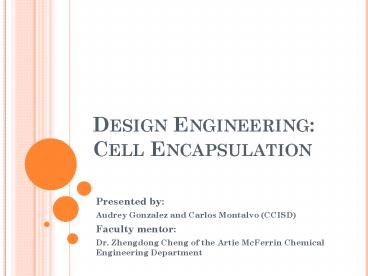Design Engineering: Cell Encapsulation PowerPoint PPT Presentation
1 / 24
Title: Design Engineering: Cell Encapsulation
1
Design Engineering Cell Encapsulation
- Presented by
- Audrey Gonzalez and Carlos Montalvo (CCISD)
- Faculty mentor
- Dr. Zhengdong Cheng of the Artie McFerrin
Chemical Engineering Department
2
Cell encapsulation
- Core element of research being bridged into
classroom project
- Encapsulating cells of interest with therapeutic
agent in a semi-permeable membrane - Implant cell capsules into human
- Cells release therapeutic substance such as
insulin for diabetics
3
Dr. Chengs lab focused on chemistry of
encapsulation
- Encapsulation is made from Alginic acid which is
insoluble in water/organic solvents and is
biocompatible
The Alginic acid encapsulation is then covered by
the polymer PNIPAM that exhibits controlled
variations of permeability
4
(No Transcript)
5
Making encapsulations in the lab
- 1. Make a solution of calcium cholride and water
and setup camera
- 2. Make a solution of alginic acid, water, and
turgitol and place in syringe pump
6
- 3. Set up syringe pump and voltage source
- 4. Test electrospray and begin making
encapsulations
7
TEXAS ESSENTIAL KNOWLEDGE AND SKILLS
Chemistry Concepts properties of water,
solubility, chemical/physical properties and
changes, density and buoyancy, atoms (TEKS 1A,
2A, 2B, 2C, 4A, 4B, 4C, 4D, 5A, 6A, (IPC 7A),
12A, 12C) Physics concepts interpreting graphs,
measurements (time, density, mass, volume,
buoyant forces, grams released per unit time),
semi-permeable membrane, design engineering (TEKS
1A, 2A, 2B, 2C, 2E, 3B, 4A, 4B, 4C, 4D) AP
Biology concepts Biomedicine (time release),
cell encapsulation, cell processes
(osmosis/diffusion, semi-permeability),
biochemistry (hydrophobic/philic bilayer,
chem/phys properties of membrane, chem/phys
changes to encapsulation, properties of water),
immune system role
- CONCEPTS AND TEKS COVERED IN PROJECT
8
Classroom project
- Timeline
- Cumulative project (7 weeks)
- Actual design, build, analysis phase (2 weeks)
- Objective
- Lab groups will be defending a cell encapsulation
design to a local pharmaceutical representative
using knowledge based on research of given
materials and data measurements.
9
Classroom project
- Proposal A local pharmaceutical company is
looking for a new way to encapsulate a drug. The
actual encapsulation must be- - 1. protective of the medicine inside
- 2. time released
- 3. selectively-permeable
10
Who cares?
11
What is the relevance?
- We need drugs on the market that are safe and
work properly.
12
What is the relevance?
- Diabetics
- About 176,500 people aged 20 years or younger
have diabetes. - As of 2005, 20.8 million people have diabetes
- The estimated economic cost of diabetes in 2002
was 132 billion. Of this amount, 92 billion was
due to direct medical costs. - www.cdc.gov/diabetes
13
What is the relevance?
- The pharmaceutical
- industry is a billion dollar industry that has
become a necessity in our allopathic culture
today.
14
Design Phase
- Students will be given 5 different semi-permeable
materials to test - Size restriction
- A design proposal will be submitted for approval
- Research
- physical and chemical properties of membrane -Do
they affect semi-permeability or density?
(Chemistry) - Bioencapsulations/Immunosuppression of (AP
Biology) - Advantages and disadvantages of time released (AP
bio/chemistry/physics)
15
Measurement phase
- Before building
- Time that it takes for small measured amount of
Tums to diffuse through each membrane - Using ratios decide time for an entire packet of
Tums quikpak to dissolve - Based on research decide if long or short
diffusion is better - Rank membranes and choose material(s)
Coffee filter
burlap
fiberglass
nylon
Pantyhose
16
Measurement phase
- Testing of encapsulation
- Mass before/after
- Volume
- Density sink, float, or suspended in water
- Find buoyant forces (physics)
- Measure mass released per unit time (extrapolate
at 2t, 4t, 6t) - Selectively permeable?
17
Analysis phase after testing and data reviewed,
defenses will begin
- Groups must clearly and concisely defend their
encapsulation product, design and material, to a
local pharmaceutical rep
18
The project
- This encapsulation is made out of a double layer
of nylon material that is surrounding an
embroidery hoop. - The therapeutic agent that is encapsulated is
a Tums quikpak.
Time for Tums to diffuse out of encapsulation
2.14 min
19
- This encapsulation is made of a double layer of
filter paper surrounding an embroidery hoop and
is encapsulating a Tums quikpak.
Time for Tums to diffuse out 3.53 min
20
Rubric for grading
21
Pre and post-test
22
Acknowledgements
- Dr. Zhengdong Cheng
- Grad student Andres Mejia
- Undergrad Lucas Kinard
23
- Dr. Cheryl Page
- Dr. Karen Butler-Purry
- Dr. Robin Autenrieth
- Jacque Hodge
- Joy Monroe
- Dr. Andy Conkey
- Dr. Arun Srinivasa
- Dr. Jennifer Welch
- All E3 participants
- Dr. Chance Lewis
24
Joys of teaching
Ma and Pa video http//www.youtube.com/watch?vBfq
5kju627c

